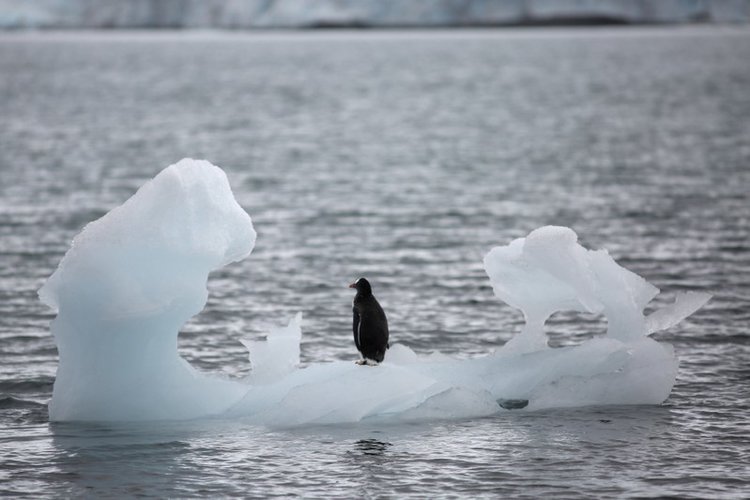(单词翻译:单击)
听力文本
Hari Sreenivasan: Antarctica, a continent of snow and ice, is now losing ice three times faster than it was in 2007. In a new study published last week in the journal Nature, more than 80 scientists from multiple countries used satellite data to examine the Antarctic's vast ice sheets. And their prediction is that if the current rate of ice melt continues, sea levels could rise six inches by the year 2100. Joining us now for more on this study and the consequences of sea level rise is Benjamin Strauss, the president and C.E.O. of Climate Central, an independent organization of scientists and journalists that research and report on the changing climate. So, first of all, this is a steady drumbeat. We've heard about sea level rise for years. How consequential, how significant is this particular study and what did it look at?
Benjamin Strauss: So the first thing I'd like to point out is Antarctica is just one part of the story. So we have six inches of contribution from Antarctica if it continues to shed ice at the rate it was measured but there are other sources as well so that altogether we would be looking at three feet.
Hari Sreenivasan: Three feet of sea level rise by the year 2100. That is consequential to hundreds of millions of people that live on coastal cities all over the planet?
Benjamin Strauss: Yes, it is. We're already seeing floods increase. Yesterday, for example, there were floods at at least eight tide gauges around the United States. Almost all of which wouldn't have happened without the sea level rise that we've already seen.
Hari Srinivasan: What is it that is convincing these scientists that the rates are changing? What are they studying? What are they looking at? How can they tell?
Benjamin Strauss: Yeah, they have a lot of direct measurements from satellites of the height of the surface of the ice sheets so they're able to see how that height changes over time. There are also amazing satellites which, in fact, measure the gravitational pull of the ice sheet and, therefore, how much ice is there. So those are the two main forms of measurement.

Hari Srinivasan: There are climate science deniers who say look at the east side of Antarctica, it looks on a map there's actually more ice coming in, doesn't this all balance itself out?
Benjamin Strauss: We do anticipate that in the future, snowfall will increase in east Antarctica and I hope so but this study shows over recent decades it hasn't. In fact, we've seen a drop in snowfall.
Hari Sreenivasan: If you take a look at some of the maps you have on your own site and you take a city like Miami, that we're all familiar that's a coastal city, and you ratchet up the scale to three feet more water. You see huge parts of what we consider to be the city of Miami under water.
Benjamin Strauss: Yeah. That's right. South Florida is severely at risk, particularly because their bedrock is porous, so even if you built levees or protective walls, water would push underneath and come up through the ground. So there are really high stakes here.
Hari Srinivasan: Even up here in the northeast, much closer to New York City, Newark, the areas around on the coastal waterway are severely impacted.
Benjamin Strauss: Yeah. A lot of airports nationwide in coastal cities are built on marshland, very...a place that's low and flat and unobstructed and away from other buildings. A lot of the them already have levees around the edges and three feet is difficult but manageable in most places. May not be manageable in south Florida. If on the other hand we continue to see the ice speeding up, we don't cut back on our climate pollution emissions, then we're pointed more towards six feet possibly and that will be unmanageable in very many places.
Hari Srinivasan: Also, the effects that we're seeing of sea level rise, of climate change in a global capacity, this is because of the carbon that we've already put into the atmosphere, not just exactly what we're doing today. So even if everyone stopped driving, all the factories shut down and somehow we didn't produce CO2, we're still going to see the effects of climate change.
Benjamin Strauss: Yes, we are. Unfortunately, once the carbon is in the atmosphere, most of it stays for hundreds and thousands of years. I think for most people, you imagine we have this problem. If it ever gets really bad that it's hurting us, drastically, we'll simply stop. We'll fix it in a few years. But the carbon keeps on insulating the earth, heating the earth more for hundreds and thousands of years. I'd say that, at a minimum, we have five more feet of sea level rise baked in and probably a good deal more if we control our pollution now, we can really slow it down a lot and make it more manageable. And that's the name of the game. Slower change will be much more manageable than the fast change. That is possible.
Hari Srinivasan: All right, Ben Strauss of Climate Central. Thanks so much.
Benjamin Strauss: Thank you.
重点解析
1.sea level 海平面
The stadium was 2275 metres above sea level.
这个体育馆海拔 2,275 米。
2.consider to be 认为
This award is considered to be a great honour.
这项奖被视为极大的荣誉。
3.as well 也
I went to New York last year, and I also spent some time in Washington.
我去年去了纽约,还在华盛顿待了些时间。
4.ice sheet 冰盖
As the ice sheet grows and thickens it chills the nearby air.
随着冰盖越来越大,越来越厚,周围的空气也冷了起来。
5.point out 指明
Critics point out that the prince, on his income, should be paying tax.
批评家指出王子的收入应该纳税。
参考译文
哈里·斯雷尼瓦桑:南极洲大陆是一片冰雪的世界,然而与2007年相比,如今它的冰融化速度快了三倍。上周,一项新的研究在《自然》杂志上发表,来自众多国家的80多名科学家,利用卫星数据对南极广阔的冰盖进行研究。他们预测,如果融冰速度照这样持续下去,到2100年,海平面将上升六英寸。现在加入我们的是气候中心主席兼首席执行官,本杰明·斯特劳斯,气候中心是由科学家及记者组成的独立团体,他们对气候变化进行研究和报告。现在关于此项研究及海平面上升的后果,本杰明·斯特劳斯为我们带来更多内容。那么,首先,这个警示一直存在。多年前,我们就已听说过海平面上升。这项研究的结果如何,它有多么重要?研究了哪些问题?
本杰明·斯特劳斯:那么,首先,我想指出,在南极州发生的事情并非孤立存在。因此,如果南极洲的融冰速度继续保持在我们测量的状态,那么它所造出的海平面上升将达到六英寸。但是除此以外,其他地区的融冰也会造成海平面上升,所以加起来,我们总共会看到三英尺的上升。
哈里·斯雷尼瓦桑:到2100年,海平面将上升三英尺。对于亿万生活在沿海城市的居民,这是他们的命运吗?
本杰明·斯特劳斯:是的,的确。我们已经看到,洪水增多。例如,昨天在美国,至少有八个潮汐测量仪监测到了洪水。如果没有我们已看到的海平面上升,所有这些几乎都不会发生。
哈里·斯雷尼瓦桑:科学家们凭借什么相信融冰速度正在改变?他们正在研究什么?他们正在观察什么?这些内容表明什么?
本杰明·斯特劳斯:是的,他们利用卫星,直接测量冰盖表面高度,因此随着时间推移,他们能够观察到冰盖高度的变化。这些卫星也真是了不起,事实上,它们对冰块的地心引力进行测量,因此,可以测量出冰量。那么这就是实施测量的两种主要形式。
哈里·斯雷尼瓦桑:有些气候科学家否认说,看看南极洲的东部,在地图上看起来,这里的冰量还在增多,难道这一切不足以带来平衡吗?
本杰明·斯特劳斯:我们的确预测到了未来,在南极洲东部,降雪量会增加,我希望如此,但这项研究表明,近几十年来,降雪量并没有增加。事实上,我们看到,降雪量反而减少了。
哈里·斯雷尼瓦桑:我们都很熟悉,迈阿密是一个沿海城市。如果你看看自己所在城市的地图,再看看像迈阿密这样城市的地图,你会把海平面上升的尺度扩大到比三英尺还多。我们认为迈阿密城市有很大一部分会被大水淹没,你可以看到这个部分有多大。
本杰明·斯特劳斯:是的,没错。南佛罗里达州正面临严重危险,特别是因为他们的基岩呈现多孔构造,所以即使你建造一个防洪堤或保护墙,水也会通过地面下渗。所以这是一次豪赌。
哈里·斯雷尼瓦桑:即使是在东北部,更靠近纽约,纽瓦克,沿海水道的周围区域也受到了严重影响。
本杰明·斯特劳斯:是的。 许多沿海城市的机场都建在沼泽地上,非常…地方又低又平,障碍物少,远离其他建筑物。许多地方也已经在边缘建立了防洪堤,三英尺对他们来说是困难,但大多数地方还是可以管控的。南佛罗里达州可能做不到。另一方面,如果冰继续加速消融,而我们又不对气候污染排放进行消减,那么我们可能离那六英尺就更近了,而很多地方将无力控制局面。
哈里·斯雷尼瓦桑:同样,我们看到气候变化所造成的海平面上升,其影响范围是全球,这是因为我们过去就已在大气中进行了碳排放,而不仅仅是因为我们今天的排放。所以即使每个人都不再开车,所有的工厂全都关闭,我们不再产生任何二氧化碳,我们仍然会看到气候变化的影响。
本杰明·斯特劳斯:是的,的确。不幸的是,一旦碳进入大气,大部分会在其中停留几十万年。我想对于大多数人来说,你认为我们面临这个问题。如果情况真的变得很糟,它严重地伤害了我们,我们会就此罢手。几年后问题就会解决。但是碳会继续存在,让地球难以散热,并在几十万年里,加热我们的地球。我想说,至少,有五英尺的海平面上升,如果我们现在控制污染的话,这可能会是笔好买卖,我们真的可以减慢海平面上升的速度,使它更易于管理。而这才是问题的实质。缓慢的变化比快速的变化更易管理。那是可能做到的。
哈里·斯雷尼瓦桑:来自气候中心的本·斯特劳斯。非常感谢。
本杰明·斯特劳斯:谢谢你。
译文为可可英语翻译,未经授权请勿转载!


